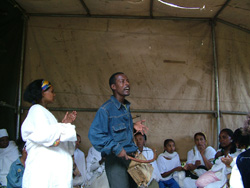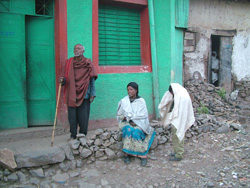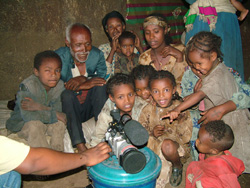| Period: 27 September 2003 - 30 September 2004. Country: Ethiopia |
|
(1) An Anthropological Study on the Process of Music Making: Performances by Azmari and Lalibalocc in Ethiopia |
| KAWASE Itsushi (Division of African Area Studies) |
| Key Words: Process of Music Making, Social Context, Azmari, Lalibalocc, Ethiopia |

An Azmari couple play for a wedding feast right before the arrival of the bride and groom.
Gondar, April 2004
|

As dawn breaks, a Lalibeloch couple and their son go from door to door blessing people with their songs.
Gondar, May 2004
|

Feedback analysis using a video camera. A Lalibeloch and his family watch a video of their own musical activities.
Gondar, July 2004
|
(2) Azmari and Lalibalocc, two genealogical groups, are familiar faces of the music culture in Ethiopia. Azmari play a one-stringed fiddle called masinqo and uplift the spirit of their audience using multiple metaphors, mimes and mimicry in festivities, rituals, and local bars. Lalibalocc, on the other hand, go from house to house singing choruses and blessing people after dawn.
I have been conducting ethnographic research on both groups since 2001 in Gondar, located in the northern part of the Amhara highland. The aim of my study is to analyze and describe the music-making process of Azmari and Lalibalocc, particularly focusing on the performers’ creativity through interactions with the audience. The study also takes the perspective of treating performances as events in an ever-changing process based on performer-audience interaction, and tries to contextualize the performance setting in a broader social context.
(3)
Filming-feedback research was implemented during the research: Performers watched the video right after the filming and discussed their musical activities with the researcher. This method allows both the researcher and the research informants to compare their understandings and explore what both see within the performance process.
The previous research revealed points which led to a new perspective for further study.
-
For Azmari, there is an emphasis on rhyming rhythm rather than having particular sentences in the song lyrics make sense. Moreover, rhyming is a kind of criteria which divides “song lyrics that work” from “song lyrics that do not work” in the cognition of the audience and performers. Thus the study should attempt to understand the performance process from the perspective of the phonological awareness of the music-making by the audience and performers.
-
Before Lalibalocc begin singing, they ask neighbors the name, religion and occupation of the owner of the house. They change the song lyrics in a flexible way according to the information they obtain from this sort of “research.” Azmari also sing the name, origin and occupation of the audience, after gaining this information from the audience. This “research” can be considered to play an important role in performer-audience interaction during the performance process.
- Azmari and Lalibalocc sing in Amharic, the daily language of the audience. However both groups maintain their own secret code of communication, which serves as a means for exchanging information that they do not want outsiders to know. The code can be used most advantageously when used during performances in front of an audience of outsiders. The current status and function of the secret code of communication will be analyzed and presented in April at the International Symposium.
|







 21st Century COE Program
-Aiming for COE of Integrated Area Studies-
21st Century COE Program
-Aiming for COE of Integrated Area Studies-